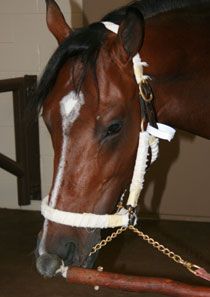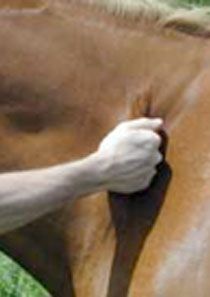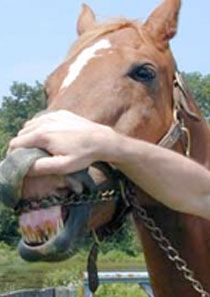7 commonly asked questions on how to use a twitch
Hey veterinary equine technicians, do you know how to properly use a twitch on your patients? Learn from the equine experts.
Next >

One of the common misunderstandings in the veterinary equine industry is how to properly use a twitch. “I would guess that fewer than 5 percent of experienced horse handlers, including equine veterinarians, know how to use a twitch effectively,” says Sue McDonnell, PhD, certified applied animal behaviorist of the University of Pennsylvania School of Veterinary Medicine in Philadelphia. Here are the answers to seven commonly asked questions. Study up to stand out next time you use a twitch.
Photo right: Here's a horse with a twitch properly applied. Note how the technician, not pictured, is holding both the twitch and shank to keep control of the horse. (Photo courtesy of Sheri Miller, LVT, of Rood and Riddle Equine Hospital in Lexington, Ky.)

1. What's the difference between a nose twitch and skin twitch?
The most common nose twitch has a long, wooden handle with a rope loop and is applied to the horse’s nose—as opposed to the neck or skin. The long handle provides greater safety for the handler as well as the horse. If you’re holding the horse, you should always maintain eye contact and be aware of the disposition of the patient during restraint.
2. How long does it take for a twitch to work?
“Just like sedation with a pharmacologic agent, a twitch takes some time to work,” McDonnell says. “It takes about three to five minutes for the endorphins released to reach effective levels.” In the meantime, the twitch is an annoyance for the horse. It can also distract the patient slightly, so be prepared to restrain the horse.
Photo upper right: Here's how to apply a skin twitch on an equine patient. Grasp the horse's loose skin just in front of the scapula and twist or roll it. (Photo courtesy of Priscilla Blackburn, MA, LVT, CVPM, of Marion duPont Equine Medical Center and Virginia-Maryland Regional College of Veterinary Medicine in Virginia.)

3. How long does it take for a twitch to wear off?
The effect of the twitch wears off quickly. Once the patient’s endorphins are released, the effect lasts about 10 to 15 minutes. After those endorphins are depleted, the horse’s endorphin levels typically plummet below baseline. “Now the horse must bear the pain of the procedure that’s in progress and he has less natural analgesia to cope with it,” McDonnell says.
4. Is it OK to use a twitch often?
Even with these caveats, McDonnell says she regularly uses nose twitches on her equine patients. She calmly applies the twitch, watches the patient for observable sedation effects (glassy eyes, droopy lips, and so on), and removes the twitch before the effect wears off so the patient is left with a “high” feeling. This way, horses hardly ever build an aversion to the twitch, she says.
Photo upper right: Be sure to grab the patient's nose firmly through the loop of the switch. (Photo courtesy of Priscilla Blackburn, MA, LVT, CVPM, of Marion duPont Equine Medical Center and Virginia-Maryland Regional College of Veterinary Medicine in Virginia.)

5. What if the horse is opposed to the nose twitch?
If you need to rehabilitate a horse from twitch aversion, repeat the process above a few times—calmly apply the twitch again, wait for its sedating effects, and then take it off while the horse is still in a “high” state.
“The nose twitch can be difficult to place—especially on tall horses—because your patient can see you approaching and might raise his head to shy away from its application,” says Jennifer Struble, an animal health technician at the UC-Davis Equine Health Center in Davis, Calif. “The neck twitch may be easier. If necessary, we use a neck twitch and grab a large chunk of the skin on the horse’s neck and hold it really tight.”
However, if a horse is opposed to the twitch don’t force the procedure. “Instead of a twitch, we’ll use lip chains on Thoroughbred racehorses because they’re used to them,” says Sheri Miller, LVT, veterinary technician at Rood and Riddle Equine Hospital in Lexington, Ky. But be careful: Some horses might not be receptive to lip chains, either.
Photo upper right: If you apply a lip chain on your patient, practice with caution so you don't damage the horse's gums or teeth. Gently pass the lip chain over the patient's nose then slip the chain under the horse's upper lip and tighten. (Photo courtesy of Priscilla Blackburn, MA, LVT, CVPM, of Marion duPont Equine Medical Center and Virginia-Maryland Regional College of Veterinary Medicine in Virginia.)

6. What are some safety tips?
You already know to stand on the same side of the horse as the veterinarian. But be sure to use the twitch on the same side of the horse as well, says Jane Tyrie, president of the American Association of Equine Veterinary Technicians and veterinary technician at the University of Pennsylvania School of Veterinary Medicine’s New Bolton Center in Kennett Square, Pa.
“The technician holding the horse should always hold the twitch and the shank chain together with two hands,” Miller says, “The technician should have her body off to the side of the horse, so if the horse kicks with his forelegs, the technician won’t get hit.” Technicians at Miller’s practice use a long-handled hickory twitch because it’s safer for the handler and the horse.
You should keep one eye on the horse and one eye on the twitch. “It’s obvious when a patient disregards the twitch,” Miller says. “He’ll throw his body around in protest and it will be clear that the twitch is not the right answer for that horse.”
7. When should I use a twitch?
Most procedures that require restraint also require a twitch to keep the horse calm and under control. “We use a twitch in most situations when a horse is being blocked or injected,” says Miller. “For some procedures, like placing catheters and exposing radiographs we sedate the patient. But for lameness exams and other general procedures we don’t use sedation, so the twitch is useful for restraint.”
Photo upper right: When you use a twitch on your patients, twist the handle toward the back of the horse until the twitch firmly tightens around the horse's nose. (Photo courtesy of Priscilla Blackburn, MA, LVT, CVPM, of Marion duPont Equine Medical Center and Virginia-Maryland Regional College of Veterinary Medicine in Virginia.)